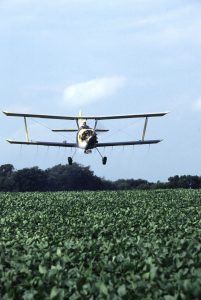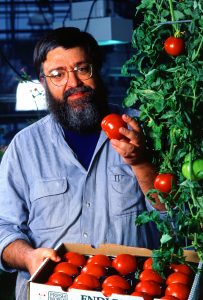Unit 1 – Food Safety
1.8 Chemical Contaminants in Foods
Some of the most common causes of chemical contamination of foods are pesticides from unwashed fruit and vegetables, cleaning products used during food preparation in the home, and unintentional chemicals that find their way into food during some aspect of the food chain. Unlike physical contaminates that cause immediate damage to the lining of the gastrointestinal tract or biological ones whose effects are evident within a few days, it may take years for chemicals that find their way into the food supply to damage your body.
Pesticides

Pesticides are important in food production to control diseases, insects, and other pests. Pesticides may be an insecticide, rodenticide, fungicide, or a herbicide, designed to destroy weeds. Pesticides are used to protect crops and ensure a large yield. However, synthetic pesticides can leave behind residues, particularly on produce, that can be harmful to human health. Foods that contain the highest levels of pesticide residue include conventionally-grown peaches, apples, bell peppers, celery, nectarines, strawberries, cherries, pears, spinach, lettuce, and potatoes. Foods that contain the lowest levels of pesticide residue include avocados, pineapples, bananas, mangoes, asparagus, cabbage, and broccoli.[1]
In many cases, the amount of pesticide exposure is too small to pose a risk. However, harmful exposures can lead to certain health problems and complications, including cancer. Also, infants and young children are more susceptible to the hazards of pesticides than adults. In addition, using synthetic pesticides and fertilizers contributes to soil and water pollution and can be hazardous to farm workers.
To protect the public and their workers, many farmers now rely on alternatives to synthetic pesticide use, including crop rotation, natural pesticides, and planting non food crops nearby to lure pests away. Some consumers choose to reduce their exposure to pesticides by purchasing organic produce. Organic foods are grown or produced without synthetic pesticides or fertilizer, and all growers and processors must be certified as “USDA Organic” in the United States or meet European Union organic criteria in Europeans countries. However, many nutritionists believe that conventionally-grown produce are fine for fruits and vegetables that appear on the low-residue list. For more information, see CDC’s Foodborne Contaminants Fact Sheet.
 |
 |
Pollutants
Pollutants are another kind of chemical contaminant that can make food harmful. Chemical runoff from factories can pollute food products and drinking water. For example, dioxins are chemical compounds created in industrial processes, such as manufacturing and bleaching pulp and paper. Fish that swim in dioxin-polluted waters can contain significant amounts of this pollutant, which causes cancer. When metals contaminate food, it can result in serious and even life-threatening health problems. A common metal contaminant is lead, which can be present in drinking water, soil, and air. Lead exposure most often affects children, who can suffer from physical and mental developmental delays as a result.

Methyl mercury occurs naturally in the environment and is also produced by human activities. Fish can absorb it, and the predatory fish that consume smaller, contaminated fish can have very high levels. This highly toxic chemical can cause mercury poisoning, which leads to developmental problems in children, as well as autoimmune effects. A condition called Minamata disease was identified in 1956 in Japan. It was named for the town of Minamata, which was the site of an environmental disaster when methyl mercury was released into the surface water near a factory. Many residents experienced neurological issues, including numbness in hands and feet, muscle weakness, a narrowing of the field of vision, damage to hearing and speech, and ataxia, which is a lack of muscle coordination.[2]
PCBs, or polychlorinated biphenyls, are man-made organic compounds that consists of carbon, hydrogen and chlorine. Due to their non-flammability, chemically stable, and high boiling points PCBs were manufactured and used commercially from 1929 until 1979 when it was banned. Like methylmercury, higher concentrations of this contaminant are found in predatory fish such as whales. Health effects include complications in physical and neurological development in children, and this compound is potentially a carcinogen.[3]
Genetically Modified (BioengineereD) Foods
Genetically modified (GM) foods (or genetically modified organisms [GMO]) have been one of the most hotly debated topics of the twenty-first century. Although they are not always contaminated with pesticides, there is a higher likelihood that GM foods have pesticide residue. The public is not as familiar with the term “bioengineered” (BE) but this is the term that USDA prefers to describe foods that were grown using biotechnology, instead of GMO. The following short USDA videos BE/GM foods.
VIDEO: Agricultural Biotechnology: Is It Called GMO or Something Else? FDA. April 22, 2020. (31 seconds)
VIDEO: “Why Do We Have GMOs”” FDA November 2020 (31 seconds)
In the United States, much of the soybean, corn, and canola crops are genetically engineered. Unlike conventional breeding and hybridization, the process involves the alteration of an organism’s DNA, which allows farmers to cultivate plants with desirable characteristics. The technology enables the direct transfer of genes between organisms in different species that would not breed in nature. [4]

For example, early scientists tried extracting a gene that produces a chemical with antifreeze properties from a cold-water fish. They thought splicing the gene into a completely different species, such as a tomato, would make them resistant to frost. If they had been successful, it would have allowed farmers to grow that crop year-round.[5] Sadly, this type bioengineering did not produce freeze resistant tomatoes. Other types of genetic engineering of tomatoes have been tried, with no success. Tomatoes sold in the US today are not bioengineered (or genetically modified). [6]
To find out which ten GM (BE) crops are grown in the United States, see the FDA GMO infographic or watch the short video.
VIDEO: What GMO Crops are Grown and Sold. FDA. (31 seconds)
Certain modifications can be beneficial in resisting pests or pesticides, improving the ripening process, increasing the nutritional content of food, or providing resistance to common viruses. Although genetic engineering has improved productivity for farmers, it has also stirred up debate about consumer safety and environmental protection. Possible side effects related to the consumption of BE/GM foods include an increase in possible allergic reactions.
Internationally, laws vary about BE/GM foods. The Center for Food Safety has an interactive map depicting laws in various countries. Notice that Serbia and Gambia ban all BE/GM foods and countries vary on how they are labeled.
There is also some concern related to the possible transfer of the genes used to create genetically engineered foods from plants to people. This could influence human health if antibiotic-resistant genes are transferred to the consumer. Therefore, the World Health Organization (WHO) and other groups have encouraged the use of genetic engineering without antibiotic-resistance genes. Genetically engineered plants may adversely affect the environment as well and could lead to the contamination of non-genetically engineered organisms.[7]
Regulation of Genetically Modified Foods
In the United States, BE/GM foods fall under the purview of the EPA, the USDA, and the FDA. Each agency has different responsibilities and concerns in the regulation of BE crops. The EPA ensures that pesticides used for BE plants are safe for the environment. The USDA makes sure genetically engineered seeds are safe for cultivation prior to planting. The FDA determines if foods made from BE plants are safe to eat. Although these agencies act independently, they work closely together and many products are reviewed by all three.[8]
Review Questions
Attributions:
- University of Hawai‘i at Mānoa Food Science and Human Nutrition Program, “Introduction,” CC BY-NC 4.0
- Pesticide Residues in Food. World Health Organization. http://www.who.int/mediacentre/factsheets/pesticide-residues-food/en/. Updated January 2018. Accessed January 28, 2018. ↵
- Minamata Disease: The History and Measures. Ministry of the Environment, Government of Japan.http://www.env.go.jp/en/chemi/hs/minamata2002/. Published 2002. Accessed December 21, 2011. ↵
- Learn About Polychlorinated Biphenyls. US Environmental Protection Agency. https://www.epa.gov/pcbs/learn-about-polychlorinated-biphenyls-pcbs#:~:text=PCBs%20belong%20to%20a%20broad,yellow%20or%20black%20waxy%20solids. Updated August 10, 2017. Accessed June 28, 2021. ↵
- What Are Genetically Modified Foods?. Genomics.Energy.gov. http://www.ornl.gov/sci/techresources/Human_Genome/elsi/gmfood.shtml. Last modified November 5, 2008. Accessed October 11, 2011. ↵
- Whitman DB. Genetically Modified Foods: Harmful or Helpful?. CSA Discovery Guides. 2000; 1-13. https://biomed.brown.edu/arise/resources/docs/GM%20foods%20review.pdf. Accessed January 20, 2018. ↵
- Lemaux, P. (2008). "Genetically Engineered Plants and Foods: A Scientist's Analysis of the Issues (Part I)". Annual Review of Plant Biology. 59: 771–812. doi:10.1146/annurev.arplant.58.032806.103840. PMID 18284373. ↵
- Food Safety: 20 Questions on Genetically Modified Foods. World Health Organization. http://www.who.int/foodsafety/publications/biotech/20questions/en/. Updated May 2014. Accessed January 18, 2018. ↵
- Whitman DB. Genetically Modified Foods: Harmful or Helpful?. CSA Discovery Guides. 2000; 1-13. https://biomed.brown.edu/arise/resources/docs/GM%20foods%20review.pdf. Accessed January 20, 2018 ↵
A substance used for destroying insects or other organisms harmful to cultivated plants or to animals. The subtypes of pesticides include insecticides, herbicides, rodenticides, and fungicides.
Foods grown or produced without synthetic pesticides or fertilizer, and all growers and processors must be certified by the US Department of Agriculture (USDA).
Growing two plants together in a special way to help the plants develop the natural traits we like

